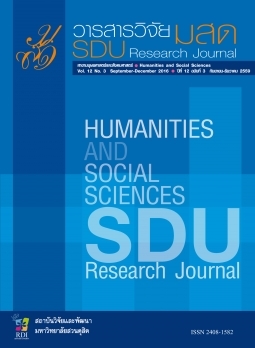การท่องเที่ยวอารยธรรมล้านนา : ข้อเสนอเชิงยุทธศาสตร์การท่องเที่ยวเชิงสร้างสรรค์
Keywords:
Lanna Civilization, Strategic Offers, Creative TourismAbstract
This is a policy research which aims to analyze the situation and the need in order
to develop creative tourism in Lanna civilization, to analyze the strategy about the
development of creative tourism in Lanna civilization and to propose and ensure the
strategy about the development of creative tourism in Lanna civilization. Data is collected
from in-depth interviews with 30 related people and 17 examining draft strategy experts.
The researcher uses EDFR method, in-depth interviews and creative dialogues to conclude
the policy recommendations. The tools used in this research are interview guidelines, field
notes, and observations. It is revealed that The tourism development of the Lanna
civilization tourism is to grow significantly. Each province has a distinct distinction, but
there are still a similar cultural identity and Lanna way of life. The creative tourism in
Lanna civilization is creating a development model, promoting marketing strategy and
connecting tourism within cluster. The strategic offers of creative tourism included 1)
Create a development model of culture and Lanna wisdom in economical aspect for the
purpose of add value in tourists’ perspectives from the identity of Lanna civilization to be
creative tourist destinations. 2) Promote marketing strategy in Thailand and foreign
countries to establish and communicate a positive image of Lanna civilization tourism
based on the participation from public and private sectors by mainly focusing on the
quality tourist market. 3) Connect tourism within cluster to increase the period of stay by
elevating tourism activities and tourism routes connectivity. The results of the Strategic
Offer were consistent.
References
http://newdot2.samartmultimedia.com/home/details/11/222/25409
กระทรวงการท่องเที่ยวและกีฬา. (2554). แผนพัฒนาการท่องเที่ยวแห่งชาติ พ.ศ. 2555 – 2559. กรุงเทพฯ
กระทรวงการท่องเที่ยวและกีฬา. (2559). สรุปสถานการณ์ท่องเที่ยวไทยปี 2558 กรุงเทพมหานคร (2559)
ยุทธศาสตร์กระทรวงการท่องเที่ยวและกีฬา พ.ศ. 2555-2559. กรุงเทพฯ
ธีระ สินเดชารักษ์ และ นาฬิกอติภัค แสงสนิท. (2556). การท่องเที่ยวเชิงสร้างสรรค์: การรับรู้ของนักท่อง
เที่ยวความพร้อมของเจ้าของกิจกรรม และความเป็นไปได้ของการท่องเที่ยวเชิงสร้างสรรค์ใน
ประเทศไทย องค์การบริหารการพัฒนาพื้นที่พิเศษเพื่อการท่องเที่ยวอย่างยั่งยืน (องค์การ
มหาชน). สืบค้น 13 มีนาคม 2559, จาก http://www.dasta.or.th/images/inter/
CT1%20TH.pdf.
ธนกฤต สังข์เฉย. (2550). อุตสาหกรรมการท่องเที่ยวและการบริการ. นครปฐม: มหาวิทยาลัยศิลปากร.
มนัสสินี บุญมีศรีสง่า. (2556). การสร้างอัตลักษณ์ตราสินค้าแหล่งท่องเที่ยวอำเภอหัวหิน จังหวัด
ประจวบคีรีขันธ์ในมุมมองนักท่องเที่ยวกลุ่มวัยรุ่น. วารสารเวอร์ริเดียน, 6(1), 548-560.
วิชานันท์ ผ่องศรี และสมพงษ์ ธงไชย. (2550). การสร้างสรรค์รูปแบบการท่องเที่ยวเชิงบูรณาการพื้นที่
อำเภอโขงเจียม จังหวัดอุบลราชธานี. Environment and natural resource journal, 5(2),
164-172.
สุพัตรา วิชยประเสริฐกุล. (2545). แนวทางการพัฒนาการท่องเที่ยวอย่างยั่งยืนของเกาะเกร็ดจังหวัดนนทบุรี
(วิทยานิพนธ์ปริญญามหาบัณฑิต). กรุงเทพฯ: จุฬาลงกรณ์มหาวิทยาลัย.
Anderson, J.E. (1994). Public Policy Making: An Introduction. 2nd.ed. New York: Houghton
Mifflin Company.
Figgis, P. & Bushell, R. (2007) Tourism as a Tool for Community-based Conservation and
Development. In R. Bushell & P.F.J. Eagles. (Eds.), Tourism and Protected Areas:
Benefits beyond Boundaries. Wallingford; Cambridge, Mass.: CABI Pub. & IUCN -
The Vth. IUCN World Parks Congress.
Rogerson, Chritstian. M. (2006). Creative industries and urban tourism: South African
Perspectives. Urban Forum, 17(2), 149-166.
Translated Thai References
Boonmeesrisa-nga, M. (2013). The Identity Construction of Destination Branding Amphoe
Hua – Hin, Prachuap Khiri Khan Province amongst Young tourists’ Perspective.
Veridian Journal, 6(1), 548-560. (in Thai)
Department Of Tourism. (2015). Summary of tourist situation on December 2015. Retrieved
March 13, 2016, from http://newdot2.samartmultimedia.com/home/details/11/
222/25409. (in Thai)
Pongsri, V & Thongchai, S. (2007). Creating integrated tourism models in Khong Chiam
District. Ubon Ratchathani Province. Environment and natural resource journal,
5(2), 164-172. (in Thai)
Sangchoey, T. (2007). Tourism and hospitality industry. NakhonPathom: Silpakorn
University. (in Thai)
Sindecharak, T. & Sangsanit, N. (2013). Creative tourism: Perception of tourists Activities of
the ownership and possibilities of creative tourism in Thailand. Designated Areas
for Sustainable Tourism Administration (Public Organization). Academic article.
Faculty of Sociology and Anthropology Thammasat University. Retrieved March
13, 2016, from http://www.dasta.or.th/images/inter/CT1%20TH.pdf. (in Thai)
Ministry of Tourism and Sports. (2011). National Tourism Development Plan 2012 – 2016.
Bangkok. (in Thai)
Ministry of Tourism and Sports. (2016). Summary of the Thai tourism situation in 2015.
Bangkok: Ministry of Tourism and Sports Strategic 2012-2016. Retrieved March 15,
2016, from http://www.mots.go.th/ewt_dl_link.php?nid=7114. (in Thai)
Wichayaprasertkul S. (2002). Guidelines for Sustainable Tourism Development of Koh Kret,
Nonthaburi Province (Master’s Thesis). Bangkok: Chulalongkorn University.
(in Thai)








